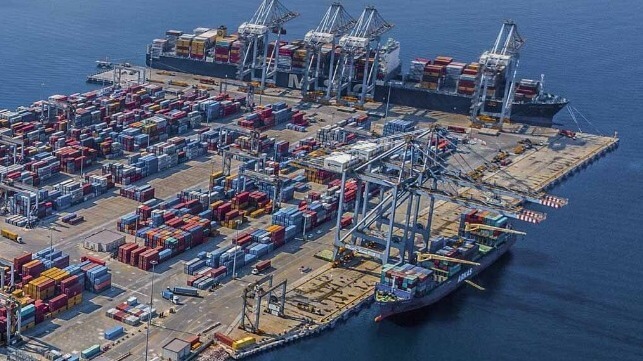DP World Targets 100M TEU Capacity as It Adds 3M More TEUs This Year

Ports operator and logistics giant DP World is in the race to hit 100 million TEUs in total gross capacity across its global footprint. By the end of 2023, they expect to add approximately three million TEUs of new container handling capacity getting them closer to the overall goal.
The company which likes to call itself a global trade enabler, currently manages approximately nine percent of the world’s handling capacity and ranks among the top five global port operators. The additional three million TUEs capacity will increase the company’s total gross capacity to 93.6 million TEUs.
The additional capacities due before the end of the year will include Caucedo in the Dominican Republic where the company will add 1.2 million TEUs, Yarimca in Turkey where it is projecting an additional 579,000 TEUs, and Sokhna in Egypt where it is adding 500,000 TEUs. Another 200,000 TEUs will be added at Jeddah in Saudi Arabia.
DP World is also set to commence operations at Indonesia’s 600,000 TEU Belawan New Container Terminal (BNCT) in North Sumatra by the end of the year. The company intends to increase BNCT’s capacity to 1.4 million TEUs and attract more direct calls, thus reducing reliance on regional hub ports, and strengthening its position as a major trade and logistics gateway in the Malacca Strait, which is a major shipping route.
The new capacity, coupled with an aggressive push by DP World to secure more port concessions across the globe, puts the company on track to reach 100 million TEUs. The company has already secured one concession this year after it was awarded the deal to develop, operate and maintain the Tuna-Tekra mega-container terminal at Deendayal port on the western coast of India. The terminal has a capacity to handle 2.19 million TEUs annually.
“We are committed to investing in our infrastructure to meet the growing demand for trade. These capacity additions will further strengthen our position as a leading global supply chain solutions provider connecting economies, businesses, and consumers around the world,” said Sultan Ahmed bin Sulayem, DP World CEO.
DP World’s capacity expansions come as UNCTAD is projecting a slowdown in global trade growth for the second quarter of 2023 driven by recently downgraded world economic forecasts and factors such as persistent inflation, financial vulnerabilities, the war in Ukraine, and geopolitical tensions. This comes on the backdrop of a positive rebound in the first quarter of the year during which trade in goods went up by 1.9 percent from the last quarter of 2022, adding about $100 billion.
“Overall, the outlook for global trade in the second half of 2023 is pessimistic, as negative factors dominate the positive,” states UNCTAD’s latest Global Trade Update.
Despite the lowered outlook for the near term, DP World is buoyed by medium-term prospects in global trade. The company expects that although current risk factors of inflation, increased cost of living, and geopolitical uncertainties are causing concern about global trade, that demand will remain for faster, more resilient supply chain solutions. According to supply chain advisor, Drewry, global container throughput will grow to 932 million TEU by 2025, up from 858 million TEU in 2021.
“We have to take a longer-term view of global economics, looking at how demand will change and how we can meet it in the most efficient way. Our medium-term target is to reach 100 million TEUs a year, subject to demand,” said Tiemen Meester, DP World, COO Ports & Terminals.
Apart from physical expansion, the company is also focusing on digitalization, implementing new technology and modern terminal operating systems. In March, DP World announced the first commercial use of its BOXBAY high-bay storage system at the Pusan Newport Corporation (PNC) terminal in South Korea where it has a 66 percent stake. The use of technology they believe will further increase capacity by automating and streamlining operations across each port, thereby enabling a greater flow of trade and more efficient processes.
